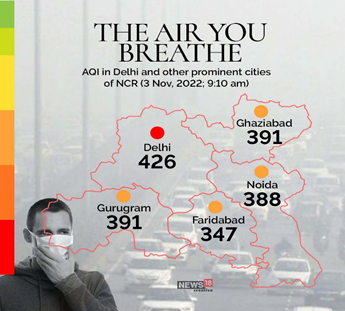

5th November 2022 (6 Topics)
Context
- Stubble burning in Punjab and Haryana is not a standalone reason for smoke and haze over Delhi.

Role of Agricultural burning:
- During this time of the year, the burning of agricultural waste in Punjab and Haryana is indeed the dominant reason for the smoke and haze over Delhi.
- The particulate matter from the burning contributes 30-40% of the PM2.5 concentrations in Delhi’s air during this time.
- It is the single largest source of PM2.5 levels on most days during this period.
Reasons for burning agricultural waste:
- This waste is the remains of the paddy crop after it has been harvested. This kind of burning is not specific only to Punjab or Haryana. However, the scale of burning in these states is much bigger than elsewhere.
- Even in these states, this practice is relatively new. Even 10 years ago, the crop-burning problem was not this acute.
- The burning is necessitated by the need to prepare the fields for the next crop in a very short window of time.
- Due to a slight shift in the cropping pattern in these states, there is now very little time between the harvesting of one crop and the planting of the next crop.
- The traditional method of manually uprooting, or cutting, the stumps of the previous crop is time-consuming and can delay the sowing of the next crop.
- So, farmers resort to the easier option of burning these remains.
|
Alternatives to Stubble Burning:
|
Role of Weather:
- A 30-40% rise in pollutants at any other time of the year would not cause the same impact.
- Agricultural waste burning in Punjab and Haryana happens in the months of May and June as well, although on a smaller scale.
- At that time, it accounts for about 15-20% of PM2.5 concentrations in Delhi’s air.
- But the air quality over the capital hardly ever becomes this bad. The reason is the weather, or rather, heat.
- Hotter air rises higher above the surface and takes the pollutants along with it.
- The polluting particles are lifted 2-3 km above the surface or even higher, before getting dispersed.
- During October-November, the air is not that hot.
- The pollutants are trapped and tend to get concentrated at lower levels of the atmosphere, resulting in the smoke and haze situation that is being witnessed now.
Impact of banning construction and diesel vehicles:
- Construction has a small contribution to PM2.5 concentration. The particles released from these activities are usually larger and add to PM10 concentrations. The banning of construction, therefore, is unlikely to have any significant impact on the prevailing situation
- Diesel vehicles, particularly older trucks, are indeed important contributors to high PM2.5 levels. And a ban on their movement can help in improving the situation to some extent.


